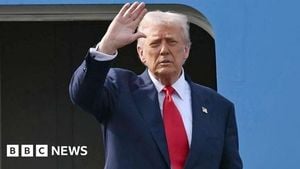For nearly three decades, Radio Free Asia (RFA) has been a lifeline for independent journalism in some of the world’s most tightly controlled societies. But as of Friday, October 31, 2025, the Washington-based broadcaster will go silent for the first time since its founding in 1996—a casualty of sweeping U.S. government funding cuts and the protracted federal shutdown that has left its newsroom in limbo.
RFA’s closure marks a turning point not only for its staff but also for millions of listeners in China, North Korea, Vietnam, Cambodia, Myanmar, and beyond. The organization, which once reached nearly 60 million people weekly in nine languages, is now shuttering its overseas bureaus, laying off its remaining journalists, and halting all programming—including its pioneering services in Uyghur, Tibetan, Burmese, and English. The move follows months of drastic retrenchment: since March, after President Donald Trump’s administration axed most funding to federally supported media, RFA had already laid off or furloughed more than 90% of its U.S.-based workforce and ceased much of its language programming by May.
“Our strategy all along has been to protect our people for as long as possible,” RFA president and CEO Bay Fang told AFP. With funding evaporated and the government shutdown entering its fifth week, Fang explained that the broadcaster would use its remaining money to provide severance packages for staff, formally ending their employment. She added that RFA is open to new revenue streams and is “trying to preserve what we would need to start back up,” but acknowledged, “I do feel like it’s a fight against the clock. We have to get this funding as quickly as possible.”
RFA’s origins trace back to the post-Cold War era, when it was launched in 1996 to bring uncensored news to countries where press freedom was virtually nonexistent. Its reporting has long been a thorn in the side of authoritarian regimes, particularly Beijing, which accuses RFA of spreading “false news.” The broadcaster has provided one of the world’s only independent Uyghur-language news services, and in 2017, it was the first to report on the arbitrary detention of more than 1 million Uyghur Muslims in China’s Xinjiang province. According to The New York Times, RFA’s investigative work has also cast a spotlight on human rights abuses in Myanmar following the military coup in 2021 and chronicled the perilous journeys of North Koreans seeking to escape their homeland.
The broadcaster’s influence is not lost on critics of the Trump administration’s funding cuts. Sophie Richardson, co-executive director of the Network of Chinese Human Rights Defenders, told AFP that shuttering RFA is “a gift to dictators like Xi Jinping,” especially “at a time when Beijing has worked quite assiduously to control what stories can and can’t get told in the country.” Richardson warned that, “in the not too distant future, we’ll see more clearly whether there are topics that become much harder to write about—or aren’t written about anymore—because we aren’t able to verify or confirm things or research trends.”
Others echoed these concerns. Nicholas Burns, a former U.S. ambassador to China under President Joe Biden and a professor at Harvard’s Kennedy School, wrote on X that the shutdown is a “major mistake” that “will prevent us from telling the truth to the Chinese people and countering Beijing’s propaganda.” Human rights activist Yaqui Wang, now a senior China researcher at Human Rights Watch, called for alternative funding sources: “Those who care about independent journalism—who care about telling the stories of human rights abuses and the struggle for freedom and dignity—must step up and support this vital work.”
The timing of RFA’s closure adds a layer of geopolitical intrigue. The news comes as President Trump is set to meet Chinese President Xi Jinping on the sidelines of the APEC summit in South Korea. RFA’s shutdown, long desired by Beijing, could be interpreted as an olive branch—or, at the very least, a significant concession at a delicate diplomatic moment. According to Deutsche Welle, RFA has long infuriated Chinese authorities, who have sought to block its transmissions and fill the resulting vacuum with state-sponsored content. The broadcaster reported that China has already moved to take over the transmission signals vacated by RFA and has stepped up its own broadcasting in Uyghur and Tibetan.
RFA is not alone in facing existential threats. The Trump administration has targeted four federally funded news organizations for closure, including Voice of America (VOA), Radio Free Europe/Radio Liberty (RFE/RL), and Middle East Broadcasting Networks. VOA, a federal agency, stopped all news production immediately after the shutdown began, despite a long history of being designated as essential to national security. RFE/RL has managed to survive in part due to pledges of support from European governments, most notably the Czech Republic. In May, the European Union provided a €5.5 million emergency injection to Radio Free Europe/Radio Liberty after its own funding was slashed.
Despite some legal victories—courts have at times ordered the Trump administration to disburse funding previously allotted by Congress—RFA’s resources have dwindled to the point of exhaustion. Cameron Lang, RFA’s associate general counsel, told The New York Times, “Instead of passing a new budget or a new appropriation of any variety, the government shut down. So there’s no money coming through.” Even if the government reopens, it remains uncertain whether RFA will be able to resume operations, as the administration can again move to cut funding, and court orders have only barred such actions for the previous fiscal year.
The consequences of these closures are far-reaching. Critics warn that withdrawing U.S.-funded independent journalism from the region cedes valuable ground to Russian and Chinese propaganda networks, which invest billions annually in spreading government-favorable content and disinformation. According to a recent State Department assessment cited by The New York Times, these adversaries have moved aggressively to fill the void left by U.S. broadcasters. The Middle East Broadcasting Networks, for example, saw its online visitors plummet from eight million a month to fewer than 300,000 after funding cuts forced it to reduce coverage.
RFA’s accomplishments have not gone unnoticed. The broadcaster recently won two Edward R. Murrow Awards for its reporting on Myanmar’s youth coping with the aftermath of the 2021 coup. RFA’s spokesman Rohit Mahajan recalled that during a devastating earthquake in Myanmar in March, “we saw our numbers really skyrocket in terms of social media engagement, because we were that last man standing, so to speak. We’re able to be that voice, that news, in that language, reporting on things like the weather and not just political insurrection or political dealings.”
As of this week, however, that voice has been silenced. The White House has not responded to requests for comment from multiple outlets. For now, RFA exists only as a shell, its future uncertain, its vital role as a check on authoritarian power left unfilled. In the words of executive editor Rosa Hwang, “China’s propaganda will fester without a potent and effective accountability check.”
With the world watching and millions left without a trusted source of independent news, the question remains: who, if anyone, will step up to fill the void?






